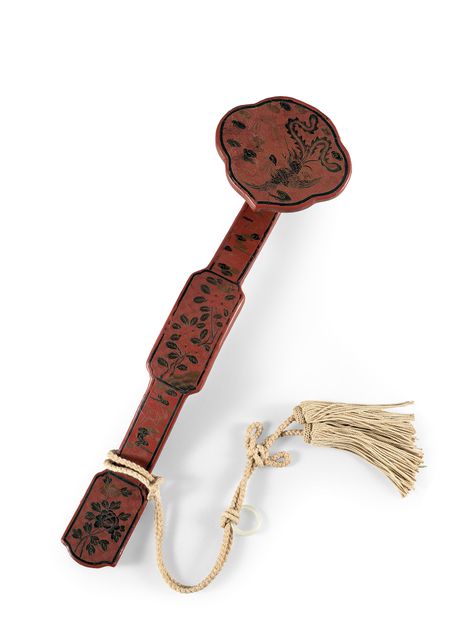

Lot 714
A PAINTED LACQUER 'PHOENIX' RUYI SCEPTRE
17th-18th Century
L: 41.4 cm
Estimate
TWD 150,000-240,000
HKD 41,000-65,000
USD 5,300-8,400
CNY 35,000-55,000
Sold Price
+ OVERVIEW
This painted lacquer ruyi scepter is luxuriously decorated, depicting blooming fauna and flora of utopia. Above the blossoming peonies and Chinese crab, a phoenix soars towards the sky among the clouds and mist. Bats encircle amidst the floating clouds, forming a delightful scene of utopia. The phoenix has round eyes and sharp beak. Its feathers sway gently along with the movement of the feathers, as a fairy dancing elegantly. Phoenix and peonies imply prosperity and abundance; while the 卍 character and bats symbolize endless blessings. Such blessed implications decorated extravagantly on the scepter accentuate the noble status of its owner.
Apart from its symbols of blessing, this ruyi scepter was cherished by its excellent craftsmanship and historical significance. The history of lacquer objects could be traced back to 6000-7000 years in the past, when it was seen as a luxury object possessed by the rich and the powerful. Since the Song dynasty, as it could be afforded by a larger audience, the surging demand encouraged the production and development of the art. Its techniques reached its peak by the Ming and Qing dynasty. Connoisseurship was common in the 17th-18th century, and scholars preferred putting lightly decorated items in their studios. Gao You of the Ming dynasty mentioned, "Painted lacquer objects are the best, followed by Xipi lacquer and cinnabar lacquer." Hence painted lacquer objects were most favoured during that period. During its meticulous production process, this ruyi was covered in layers of lacquers of many colours, polished and carved into its final desired form, thus enhancing its value amongst studio objects. Similar painted lacquer ruyi was offered in the Autumn Sale 2017 (Lot 3044) at Christie's Hong Kong, sold for around NTD 550,000, thus proving the popularity and rarity of such painted lacquer objects.
Apart from its symbols of blessing, this ruyi scepter was cherished by its excellent craftsmanship and historical significance. The history of lacquer objects could be traced back to 6000-7000 years in the past, when it was seen as a luxury object possessed by the rich and the powerful. Since the Song dynasty, as it could be afforded by a larger audience, the surging demand encouraged the production and development of the art. Its techniques reached its peak by the Ming and Qing dynasty. Connoisseurship was common in the 17th-18th century, and scholars preferred putting lightly decorated items in their studios. Gao You of the Ming dynasty mentioned, "Painted lacquer objects are the best, followed by Xipi lacquer and cinnabar lacquer." Hence painted lacquer objects were most favoured during that period. During its meticulous production process, this ruyi was covered in layers of lacquers of many colours, polished and carved into its final desired form, thus enhancing its value amongst studio objects. Similar painted lacquer ruyi was offered in the Autumn Sale 2017 (Lot 3044) at Christie's Hong Kong, sold for around NTD 550,000, thus proving the popularity and rarity of such painted lacquer objects.
Related Info
Refined Brushwork: Fine Chinese Paintings and Works of Art
Ravenel Spring Auction 2021 Taipei
Saturday, July 17, 2021, 1:30pm
